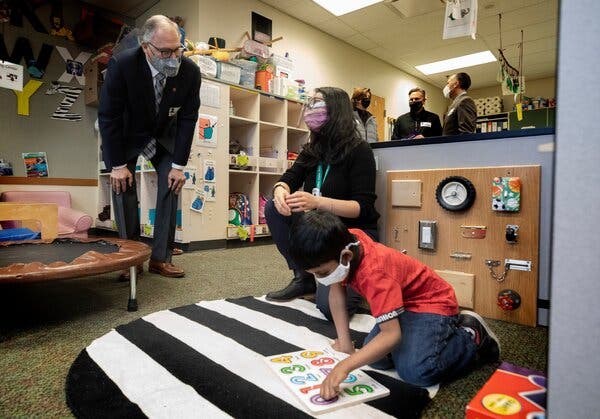
All teachers and school personnel in Washington State — including coaches, bus drivers and volunteers — will need to be fully vaccinated as a condition of employment, under a new policy announced by Gov. Jay Inslee on Wednesday. The requirement applies to staff regardless of the type of school in which they work: public, charter or private.
The policy is the strictest vaccine mandate imposed to date by any state for teachers and other staff members in schools, allowing for only a few exceptions. School staff must be vaccinated by Oct. 18 or face possible dismissal.
“We are well past the point where testing is enough to keep people safe,” Mr. Inslee said at a news conference. “We’ve tried it. It has not been adequate for the task at hand.”
He stressed that 95 percent of patients hospitalized with Covid-19 in Washington were unvaccinated, and reminded the public that children under 12 were not yet eligible for vaccines.
“When you decide to get a vaccine, you’re protecting a kid out there who can’t get it,” he said.
Vaccine mandates have been hotly debated across the country, with a quarter of states, generally those led by Republicans, banning vaccine requirements for public employees like school staff, according to the University of Washington’s Center on Reinventing Public Education. But in recent days, some Democratic officials have moved to require the shots.
Gov. Gavin Newsom of California has offered teachers in public and private schools the option of either vaccination or regular virus testing. City school systems in Los Angeles and Chicago have gone further, requiring staff vaccination, though there is an exemption process for those with disabling medical conditions or sincerely held religious beliefs.
Washington’s policy goes further than California’s. There is no option to choose regular testing instead of vaccination. There are limited exceptions, however, including for legitimate medical reasons and sincerely held religious beliefs. Individuals who refuse to get vaccinated will be subject to dismissal.
The state had already announced a mask mandate inside schools. It is experiencing a Covid-19 case surge that is straining its health care system.
Washington lagged behind most of the rest of the nation in reopening schools during the last academic year, as teachers’ unions across the state pushed for longer periods of remote learning, stricter virus safety measures in classrooms and access to vaccines for educators. All districts are planning to return to in-person learning five days a week this fall. Most districts reopen in early September.
Vaccine and mask mandates will ensure that schools can remain open, said Chris Reykdal, the state superintendent of public instruction. Extended school closures have affected children’s learning — especially the least advantaged — and put strain on working mothers, he added. When school staff get vaccinated, “you are creating the buffer and protection for young people,” Mr. Reykdal said.
On Wednesday, a spokeswoman for the Washington Education Association, the state’s largest teachers’ union, said she expected local chapters would be able to negotiate some details of the vaccine requirement. The union said in a statement that it “encourages everyone who can to get vaccinated immediately” and emphasized the continued importance of other safety measures in schools, such as masks, contact tracing, testing and social distancing.
Jennifer Matter, president of the Seattle Education Association, which is the teachers’ union in the state’s largest school district, said that the union and state “have a shared interest in creating a vaccine requirement to keep our community safe.”
Ms. Matter said that her union planned to negotiate with the district on how the mandate would be implemented. The negotiations could include a process for requesting an exemption or provisions for time off to get a vaccine or recover from side effects, she said.
Leaders of the two national teachers’ unions, the National Education Association and the American Federation of Teachers, have said that they support vaccine mandates for school staff.
The governor also announced new mandates for workers in the state’s colleges and universities, as well as for many child care workers. And he announced that the state’s indoor mask mandate would be expanded to include vaccinated individuals.

The Centers for Disease Control and Prevention released three studies on Wednesday that federal officials said provided evidence that booster shots of the Pfizer-BioNTech and Moderna coronavirus vaccines would be needed in the coming months.
But some experts said the new research did not back up the decision to recommend booster shots for all Americans.
Taken together, the studies show that although the vaccines remain highly effective against hospitalizations and deaths, the bulwark they provide against infection with the virus has weakened in the past few months.
The finding accords with early data from seven states, gathered this week by The New York Times, suggesting a rise in breakthrough infections and a smaller increase in hospitalizations among the vaccinated as the Delta variant spread in July.
The decline in effectiveness against infection may result from waning vaccine immunity, a lapse in precautions like wearing masks or the rise of the highly contagious Delta variant, experts said — or a combination of all three.
“We are concerned that this pattern of decline we are seeing will continue in the months ahead, which could lead to reduced protection against severe disease, hospitalization and death,” Dr. Vivek Murthy, the surgeon general, said at a White House news briefing on Wednesday.
Citing the data, federal health officials outlined a plan for Americans who received the two vaccines to get booster shots eight months after receiving their second doses, starting Sept. 20.
People who received the Johnson & Johnson vaccine may also require additional doses. But that vaccine was not rolled out until March 2021, and a plan to provide boosters will be made after reviewing new data expected over the next few weeks, officials said.
Some scientists were skeptical of the administration’s new initiative.
“These data support giving additional doses of vaccine to highly immunocompromised persons and nursing home residents, not to the general public,” said Dr. Céline Gounder, an infectious disease specialist at Bellevue Hospital Center in New York and a former adviser on the pandemic to the administration.
Boosters would only be warranted if the vaccines were failing to prevent hospitalizations with Covid-19, she said.
“Feeling sick like a dog and laid up in bed, but not in the hospital with severe Covid, is not a good enough reason” for a campaign of booster shots, Dr. Gounder said. “We’ll be better protected by vaccinating the unvaccinated here and around the world.”
It’s also unclear whether a third dose would help people who did not produce a robust immune response to the first two doses, said Bill Hanage, an epidemiologist at the Harvard T.H. Chan School of Public Health.
And the recommendation for boosters may also end up undermining confidence in the vaccines, he warned: “A third shot will add to skepticism among people yet to receive one dose that the vaccines help them.”
Together, the new studies indicate overall that vaccines have an effectiveness of roughly 55 percent against all infections, 80 percent against symptomatic infection, and 90 percent or higher against hospitalization, noted Ellie Murray, an epidemiologist at Boston University.
“Those numbers are actually very good,” Dr. Murray said. “The only group that these data would suggest boosters for, to me, is the immunocompromised.”
Dr. Murray said a booster shot would undoubtedly boost immunity in an individual, but the added benefit may be minimal — and obtained just as easily by wearing a mask, or avoiding indoor dining and crowded bars.
The administration’s emphasis on vaccines has undermined the importance of building other precautions into people’s lives in ways that are comfortable and sustainable, and bolstering capacity for testing, Dr. Murray and other experts said.

The Biden administration moved on several fronts Wednesday to fight back against the surging Delta variant of the coronavirus, strongly recommending booster shots for most vaccinated Americans and using federal leverage to force nursing homes to vaccinate their staffs.
In remarks from the East Room of the White House, President Biden also directed his education secretary to “use all of his authority, and legal action if appropriate,” to deter states from banning universal masking in classrooms.
That move will involve deploying the department’s civil rights division and is destined to escalate a fight between Mr. Biden and Republican governors who are blocking local school districts from requiring masks to protect against the virus.
The dramatic shifts in strategy reflect the administration’s concerns that the Delta variant is erasing its hard-fought progress against the pandemic and thrusting the nation back to where it was early in the year.
“The threat of the Delta virus remains real, but we are prepared, we have the tools, we can do this,” Mr. Biden said in the East Room, adding, “This is no time to let our guard down.”
In the past, Mr. Biden has been reluctant to use the federal government’s power to withhold federal funding or intervene in school policies to order protective measures or force more vaccinations. But that changed on Wednesday, when he said his administration would make employee vaccination a condition for nursing homes to receive Medicare and Medicaid funding. Officials said the decision would affect more than 15,000 nursing homes that employ 1.3 million workers.
For many Americans, the booster strategy will affect them the most. The government plans to offer third shots to adults who received the Pfizer-BioNTech or Moderna vaccines eight months after they received their second dose, starting Sept. 20. About 150 million Americans have been fully immunized with one of those two vaccines.
Officials stressed that the Food and Drug Administration still needs to make a final determination that third shots are safe and effective — a ruling expected in the coming weeks.
On Wednesday afternoon, the president said his administration had been planning for the possibility of booster shots for months. The extra shots “will make you safer for longer,” he said.
“The best way to protect ourselves from new variants that could arise is for every, every adult to get a booster shot,” he said, adding that everyone who is not vaccinated yet should go get their shots quickly.
Senior federal officials said that the booster strategy stemmed from new data showing that vaccine efficacy against infection and mild disease wanes over time. They voiced concern that the vaccines’ protection against serious disease could also decrease in coming months.
“Here’s what you need to know: If you are fully vaccinated, you still have a high degree of protection from the worst outcomes of Covid-19 — severe disease, hospitalization and death,” Dr. Vivek Murthy, the surgeon general, said. “We are not recommending that you go out and get a booster today.”
Daniel E. Slotnik contributed reporting.
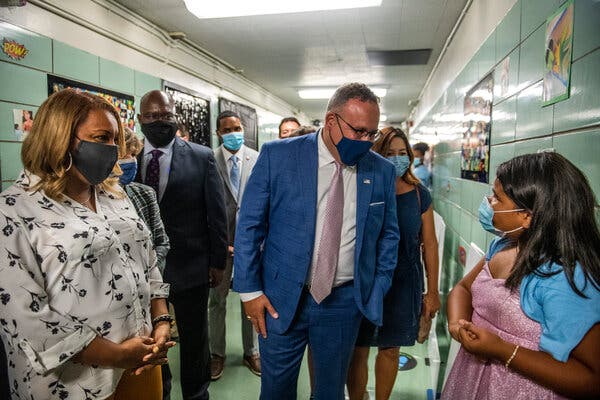
President Biden, escalating his fight with Republican governors who are blocking local school districts from requiring masks to protect against the coronavirus, said Wednesday that his Education Department would use its broad powers — including taking possible legal action — to deter states from barring universal masking in classrooms.
Mr. Biden said he had directed Miguel Cardona, his education secretary, “to take additional steps to protect our children,” including against governors who he said are “setting a dangerous tone” in issuing executive orders banning mask mandates and threatening to penalize school officials who defy them.
“Unfortunately, as you’ve seen throughout this pandemic, some politicians are trying to turn public safety measures — that is, children wearing masks in school — into political disputes for their own political gain,” Mr. Biden said in remarks from the East Room of the White House, adding, “We are not going to sit by as governors try to block and intimidate educators protecting our children.”
The federal intervention comes as school districts face the monumental task of trying to get students back to in-person learning and reverse the devastating setbacks experienced by a range of students. Mr. Biden’s move puts the federal government at the center of bitter local debates over how to mitigate against the virus in schools, just as the highly infectious Delta variant is fueling a spike in pediatric cases.
In an interview on Wednesday, Dr. Cardona said that like the president, he was “appalled that there are adults who are blind to their blindness, that there are people who are putting policies in place that are putting students and staff at risk.”
“At the end of the day,” he said, “we shouldn’t be having this conversation. What we’re dealing with now is negligence.”
Dr. Cardona said he would deploy the Education Department’s civil rights enforcement arm to investigate states that block universal masking. The move marks a major turning point in the Biden administration’s effort to get as many students as possible back to in-person schooling this fall.
The nation’s most vulnerable students, namely students with disabilities, low-income students and students of color, have suffered the deepest setbacks since districts pivoted to remote learning in March 2020, and their disproportionate disengagement has long drawn concern from education leaders and civil rights watchdogs.
Under Section 504 of the Rehabilitation Act of 1973, students are entitled to a free, appropriate public education, known as FAPE, and Title VI of the Civil Rights Act of 1964 prohibits discrimination based on race, color and national origin.
If state policies and actions rise to potential violations of students’ civil rights, the department could initiate its own investigations into districts and investigate complaints made by parents and advocates who argue that prohibiting mask mandates could deny students’ right to education by putting them in harm’s way in school.
A report released by the department’s civil rights office this summer provided a snapshot of the suffering students have experienced. It noted that the pandemic challenges were particularly acute for students with disabilities, whose educational success relies on classroom time and hands-on services.
“I’ve heard those parents saying, ‘Miguel, because of these policies, my child cannot access their school, I would be putting them in harm’s way,’” Dr. Cardona said. “And to me, that goes against a free, appropriate public education. That goes against the fundamental beliefs of educators across the country to protect their students and provide a well-rounded education.”
The administration will also send letters to six states — Arizona, Iowa, Oklahoma, South Carolina, Tennessee and Utah — admonishing governors’ efforts to ban universal masking in schools.
Last week, Dr. Cardona sent similar letters to the governors of Texas and Florida, reminding them that districts had both the funding and the discretion to implement safety measures that the C.D.C. recommended for schools. The secretary also made it clear that he supported district leaders who defied the governors’ orders.
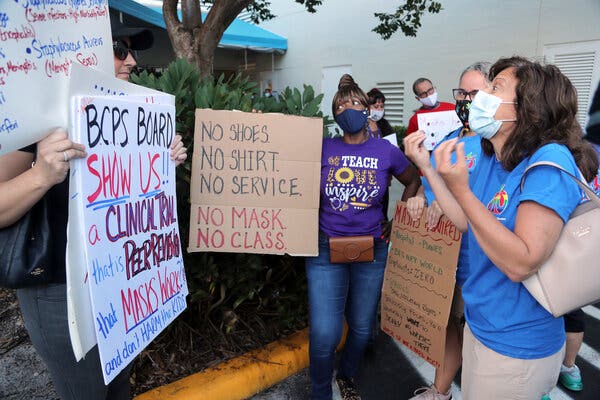
Florida’s state board of education threatened this week to penalize local school board members and superintendents in Broward and Alachua Counties because they were requiring students to wear masks at school.
But those threats did not stop Florida’s largest school district, Miami-Dade, as well as the school district in Hillsborough County, which includes Tampa, from approving similarly strict mask mandates on Wednesday, in further defiance of the state board.
“Yesterday, I spoke with a mother of a child who died,” Alberto Carvalho, the superintendent of the Miami-Dade County Public Schools, told the state board of education on Wednesday. “Over the week, I’ve spoken with employees and their relatives, begging me to do the right thing.”
He said he would “wear proudly as a badge of honor” any consequences that may come from his recommendation to require masks, which the school board adopted with a 7-1 vote later on Wednesday.
Lubby Navarro, a board member, cast the lone dissenting vote. “I am not going to sit here and violate state law,” she said.
Battles over school mask policies have engulfed Florida as hospitals have filled with Covid-19 patients, many of them young people. In Broward County, local officials warned this week that only five beds remained available in pediatric intensive care units there.
This month, Gov. Ron DeSantis, a Republican, ordered school districts to allow parents to opt out of mask requirements for their children. He also allowed parents whose children feel “bullied” by mask mandates to apply for a private-school voucher.
The Hillsborough County Public Schools began the school year on Aug. 10 with parents allowed to opt out of its mask requirement. But the district quickly found so much virus in its schools that the board called a special meeting on Wednesday to consider stricter rules. They voted 5-2 to limit mask opt-outs to students with medical exemptions, in spite of a recommendation from Addison G. Davis, the superintendent, that the district keep its existing rules.
“Right now, I think it’s really important to mask our children,” said Nadia T. Combs, one of the board members. She added that she’s “not here for the adults.”
“I’m not here for politics,” she said. “I’m here to keep kids in school.”
In the last week, the district has had to quarantine or isolate 10,384 out of its more than 214,000 students — nearly 5 percent — because of virus exposure.
The emotional meeting in Tampa on Wednesday featured masked parents — some of them health care workers wearing scrubs — pleading for a stronger mandate, and unmasked parents — some of them wearing “Freedom Fighter” T-shirts — insisting on keeping the existing rules.
“My children need to be unmasked,” said Kelly Boynton, one of the opponents. “It’s tyranny.”
Before the meeting, Jennifer Buschner, who has two children in the district, said that her daughter, who is in second grade and has a rare genetic disorder, had hoped to return to the classroom, but the lack of a mask mandate made it too dangerous.
“I was appalled,” Ms. Buschner said. “They took my daughter’s safety away from her, and made it so that she has to be home.”
The county school boards in Alachua (based in Gainesville) and Broward (in Fort Lauderdale) each voted to require masks, with allowances for medical exemptions signed by a physician or other health care provider. The districts argued that such a mandate complied with both state health regulations and the governor’s order.
But the state board of education disagreed. On Tuesday, the board directed the state commissioner of education to investigate and punish the two districts by withholding funds, suspending or removing school board members, or withholding their salaries.
President Biden has condemned states that are blocking mask rules in local schools, saying they are putting politics above public health. His administration has offered to step in and help the districts financially or cover board members’ salaries if the state imposes those sanctions.
On Wednesday, Education Secretary Miguel Cardona said that the administration would use the Department of Education’s civil rights enforcement authority to deter states from banning universal mask mandates in classrooms.
Hours after the Florida state board of education threatened to penalize the two districts, the Alachua school board unanimously extended its mask mandate for eight more weeks.
“That’s not defying me — that’s defying the state of Florida’s laws,” Mr. DeSantis told reporters in Broward on Wednesday. “That was the Legislature of Florida that said the parents are the ones that have ultimate responsibility for health, education and welfare.”
Vickie Cartwright, the interim superintendent of the Broward County Public Schools, said that district officials agreed with the governor’s view that children need to be in brick-and-mortar schools to do their best learning, and that was why the masks were necessary, amid so much virus spread.
“We want our students back in person,” Dr. Cartwright said in an interview on Wednesday. “We want to keep them there.”
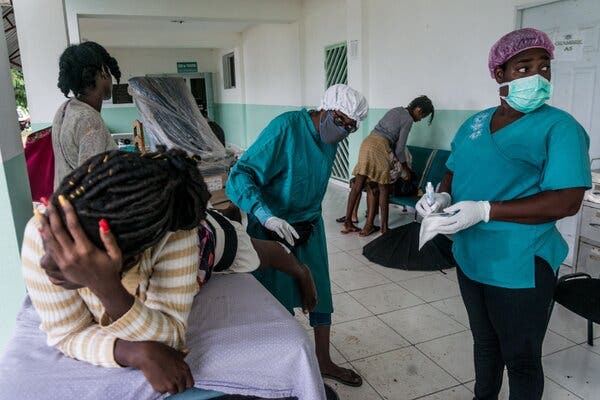
The recent deadly earthquake in southern Haiti and flash flooding from a tropical storm have set back efforts to contain the coronavirus pandemic and administer vaccines in the country, World Health Organization officials said on Wednesday.
“The earthquake aftermath combined with the Covid-19 pandemic presents a very challenging situation for the people of Haiti,” Dr. Carissa Etienne, director of the Pan American Health Organization, a part of the W.H.O., said at a news briefing.
The disasters, she said, have added another major burden to an already strained health care system in an impoverished country that has been going through a political crisis since the assassination of its president last month.
The powerful 7.2-magnitude earthquake that struck Haiti’s southern peninsula over the weekend left at least 1,941 people dead and about 9,900 more injured. Heavy rains from Tropical Storm Grace then swept the country on Monday and Tuesday, touching off flash floods and landslides. According to the W.H.O., four health facilities in the country were destroyed in the disasters, and 20 more were damaged.
As overwhelmed hospitals turn their attention to disaster victims, fewer resources are available to treat Covid-19, Dr. Etienne said. It has also become more difficult to move medical supplies and personnel around the country. And it is difficult to keep the coronavirus from spreading readily in crowded emergency shelters.
“With disruptive storms and hurricanes, the potential for an increase in cases is very high,” she added.
Coronavirus vaccines were slow to trickle into Haiti even before the disasters. The 500,000 doses of the Moderna vaccine that reached Haiti last month through the Covax vaccine-sharing initiative were the first significant supplies to reach the country. Only 21,000 people had received a dose by Tuesday, with health workers first in line, according to Dr. Jarbas Barbosa, the assistant director of P.A.H.O.
“We are working with the Ministry of Health to expedite the process,” Dr. Barbosa said, adding that access to vaccination was especially important in the earthquake zone where people are living in makeshift shelters.
Only about one in five people in Latin America is fully vaccinated so far, and vaccine supplies have been slow to arrive in many countries. In Caribbean and Central American nations, Dr. Barbosa said, vaccine hesitancy is emerging as a major new threat to immunization.
At the same time, new case reports have been rising sharply, Dr. Etienne said, with spikes in Jamaica, Cuba, Costa Rica, Dominica and Belize.
As hurricane season intensifies over the next few months, officials will remain “vigilant,” she said, about further strains on health care systems in vulnerable countries that could hamper efforts to reduce Covid-19 transmission.
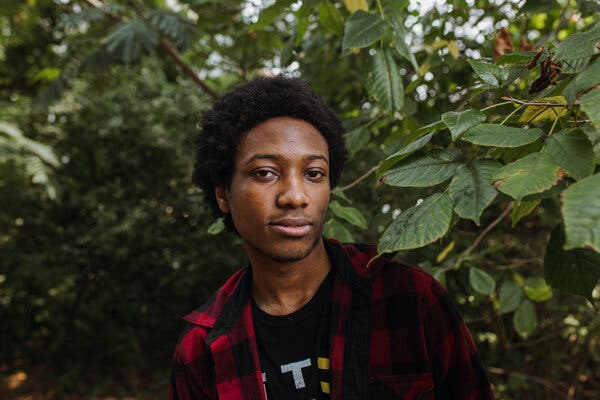
Mark Wray was working at the concession stand of a movie theater when the pandemic lockdowns hit last year. The movie theater shut down, and he lost his job.
But instead of looking for another low-wage job, Mr. Wray found a program teaching basic technology and business skills, completed it and landed a job at a fast-growing online mortgage lender. He started in March, working in customer service and tech support. He makes about $55,000 a year, compared with $17,000 at the movie theater.
“The pandemic, weirdly, was an opportunity,” said Mr. Wray, 25, who is a high school graduate and lives in Charlotte, N.C.
People returning to the work force after the pandemic are expecting more from their employers, pushing companies to raise pay, give bonuses and improve health care and tuition plans. Paychecks are getting bigger. Wages rose strongly in July, up 4 percent from a year earlier, according to the Labor Department.
Yet many workers are also seeking something else: a career path, not a dead-end job.
For many, the issue is less about bargaining for more money in a tight labor market than about finding a job with a brighter future.
“People in lower-wage work are saying, ‘I’m going to pivot to something better,’” said Stuart Andreason, director of the Center for Workforce and Economic Opportunity at the Federal Reserve Bank of Atlanta.
Their demands are already reshaping corporate policies. Major employers of lower-wage hourly workers including Amazon, Chipotle and Walmart have announced improvements to their tuition and training programs.
People who have worked in the field of work force development for decades say they see evidence of genuine change. In the past, for example, companies often blamed the education system for failing to produce enough qualified people of color to hire, said Elyse Rosenblum, founder and managing director of Grads of Life, which advises businesses on inclusive hiring practices.
“But now, companies are increasingly looking internally and taking ownership of this challenge,” Ms. Rosenblum said. “That’s a completely different posture.”
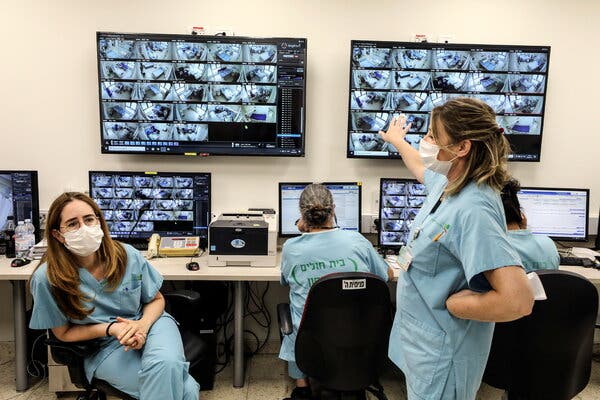
Last spring, Israel’s remarkably swift vaccination campaign was seen as a global model. Coronavirus infections plummeted, an electronic pass allowed the vaccinated to attend indoor concerts and sporting events, and distancing rules and mask mandates were eventually scrapped.
Israel offered the world a hopeful glimpse of the way out of the pandemic.
No longer.
A fourth wave of infections is rapidly approaching the levels of Israel’s worst days of the pandemic last winter. The daily rate of confirmed new virus cases has more than doubled in the last two weeks, making Israel a rising hot spot on the international charts.
Restrictions on gatherings and commercial and entertainment venues were reinstated this week, and the government is considering a new lockdown.
“I believe we are at war,” Israel’s coronavirus commissioner, Prof. Salman Zarka, told a parliamentary committee on Wednesday.
Scientists are still assessing how Israel’s pandemic response plunged from shining example to cautionary tale, and the stunning reversal has provided a crucial test for Israel’s new prime minister, Naftali Bennett, who staked a claim for leadership partly on the strength of his manifesto, “How to Beat a Pandemic.”
But some experts fear that Israel’s high rate of infections among early vaccine recipients may indicate a waning of the vaccine’s protections over time, a finding that contributed to a U.S. decision Wednesday to begin offering booster shots to Americans widely starting next month.
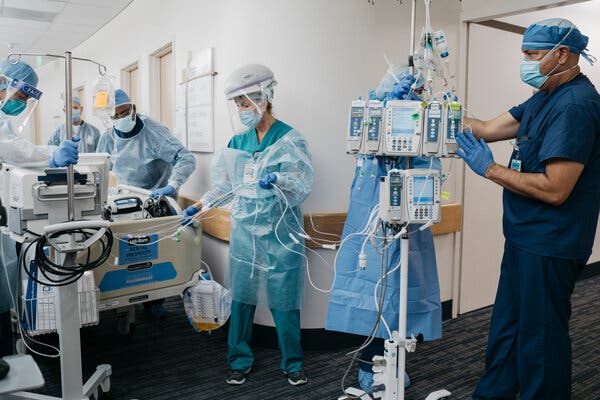
Since Americans first began rolling up their sleeves for coronavirus vaccines, health officials have said that those who are immunized are very unlikely to become infected, or to suffer serious illness or death. But preliminary data from seven states hints that the arrival of the Delta variant in July may have altered the calculus.
Breakthrough infections in vaccinated people accounted for at least one in five newly diagnosed cases in six of those states and higher percentages of total hospitalizations and deaths than had been previously observed in all of them, according to figures gathered by The New York Times.
The absolute numbers remain very low, however, and there is little doubt that the vaccines remain powerfully protective. This continues to be “a pandemic of the unvaccinated,” as federal health officials have often said.
Still, the trend marks a change in how vaccinated Americans might regard their risks.
“Remember when the early vaccine studies came out, it was like nobody gets hospitalized, nobody dies,” said Dr. Robert Wachter, chairman of the department of medicine at the University of California, San Francisco. “That clearly is not true.”
The figures lend support to the view, widely held by officials in the Biden administration, that some Americans may benefit from booster shots in the coming months. Federal officials plan to authorize additional shots as early as mid-September, although it is not clear who will receive them.
“If the chances of a breakthrough infection have gone up considerably, and I think the evidence is clear that they have, and the level of protection against severe illness is no longer as robust as it was, I think the case for boosters goes up pretty quickly,” Dr. Wachter said.
The seven states — California, Colorado, Massachusetts, Oregon, Utah, Vermont and Virginia — were examined because they are keeping the most detailed data. It is not certain that the trends in those states hold throughout the United States.
In any event, scientists have always expected that as the population of vaccinated people grows, they will be represented more frequently in tallies of the severely ill and dead.
“We don’t want to dilute the message that the vaccine is tremendously successful and protective, more so than we ever hoped initially,” said Dr. Scott Dryden-Peterson, an infectious disease physician and epidemiologist at Brigham & Women’s Hospital in Boston.
“The fact that we’re seeing breakthrough cases and breakthrough hospitalizations and deaths doesn’t diminish that it still saves many people’s lives.”

World Health Organization officials warned on Wednesday that the Taliban takeover of Afghanistan was impeding efforts to address the coronavirus pandemic and other dire health crises there.
Gauging the spread of the coronavirus in Afghanistan has always been difficult because of a lack of testing. The average daily number of reported new cases peaked in late June at more than 2,000 and has since fallen sharply, according to the Our World in Data project at the University of Oxford. But it is likely that the figures do not reflect the actual spread of the virus.
Afghanistan’s vaccination efforts have struggled since they began in the spring, harassed by corruption, limited public health resources and widespread public skepticism. According to Our World in Data, less than 2 percent of Afghanistan’s population has been vaccinated.
“In the midst of a pandemic, we’re extremely concerned by the large displacement of people and increasing cases of diarrhea, malnutrition, high blood pressure, probable cases of Covid-19 and reproductive health complications,” Dr. Tedros Adhanom Ghebreyesus, the W.H.O.’s director general, said at a news conference.
He said that agency staff members were still in Afghanistan and were “committed to delivering health services to the most vulnerable.”
Many Afghans are vulnerable to diseases like polio, which has been eradicated in most of the world but is still endemic there. Fourteen million Afghans are suffering from hunger, United Nations officials said on Wednesday.
Aid groups are struggling to provide humanitarian assistance inside Afghanistan and to the tens of thousands of refugees a week who are fleeing to neighboring countries. Refugee camps, with their crowded and often unsanitary conditions, can become incubators for the virus, though many camps have fared better than experts initially feared they would.
U.N. officials said that their agencies in Afghanistan were in contact with the Taliban in an effort to coordinate aid and immunizations. Caroline Van Buren, a representative of the U.N. High Commissioner for Refugees, said that the Taliban had so far provided protection for all of the refugee agency’s offices in the country.
At the same time, though, the Taliban have resumed some of the practices common when they held power 20 years ago. Ms. Van Buren said that officials had received reports of women being prohibited from going to work, and, in some areas, barred from leaving their homes without being accompanied by a close male relative.

There wasn’t a single I.C.U. bed available in Alabama on Wednesday, a possible sign of what other states may confront soon amid a deadly surge of new infections in parts of the United States with low vaccination rates.
I.C.U. beds are filling up across Southern states, and Alabama is one of the first to run out. The Alabama Hospital Association said on Wednesday night that there were “negative 29” I.C.U. beds available in the state, meaning there were more than two dozen people being forced to wait in emergency rooms for an open I.C.U. bed.
The situation has grown desperate in Alabama, one of several states reporting a wave of cases driven by the highly contagious Delta variant and low vaccination rates.
Last week, at least two hospitals in Houston were so overwhelmed with virus patients that officials erected overflow tents outside. Elsewhere in Texas, in Austin, hospitals were nearly out of beds in their intensive care units. And in San Antonio, cases reached levels not seen in months, with children as young as 2 months old tethered to supplemental oxygen.
Arkansas hospitals were also close to capacity.
Only 47 percent of people in Alabama are at least partially vaccinated, far lower than the national rate of 60 percent, according to a New York Times database.
On Monday, the seven-day hospitalization average hit 2,603, up from a low of 252 on June 26. Only January’s numbers were higher, when the seven-day average peaked at more than 3,300 on Jan. 10.
Gov. Kay Ivey of Alabama said last month that the surge in new cases was attributable to the large number of people who remain unvaccinated. On Friday, she reinstated Alabama’s state of emergency, which had expired in early July, in an effort to expand hospital capacity.